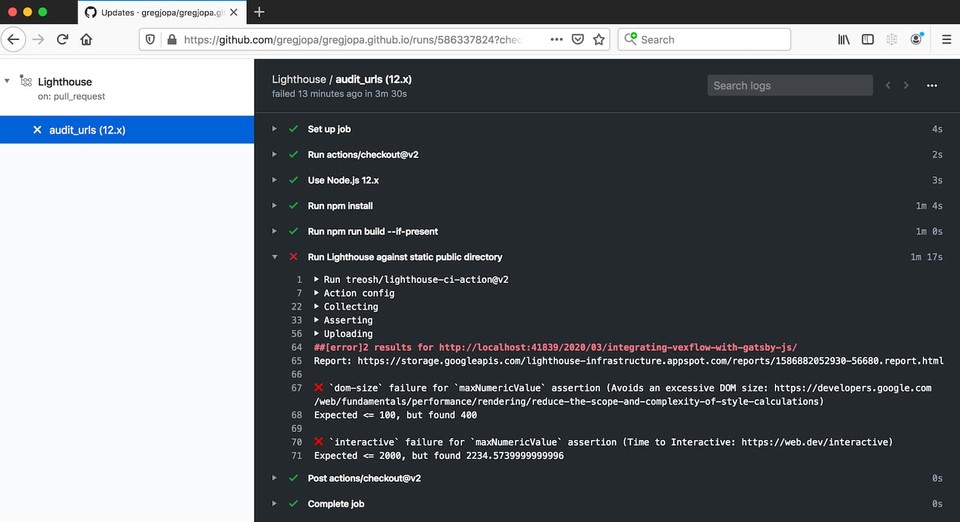Lighthouse Audits for Static Sites with GitHub Actions
— Gatsby.js, Lighthouse, Continuous Integration
The project Lighthouse CI Action makes it easy to run Lighthouse Audits with GitHub Actions. The audit results can be used to enforce a performance budget for your website. For example, here's what a job failure looks like when the DOM Size and Time To Interactive (TTI) metrics exceed the performance budget:

In this post I'll explain how I set up a performance budget for my personal blog which is built with Gatsby.js.
GitHub Action Setup
The examples in the Lighthouse CI Action docs are a great way to learn what configurations are possible. I followed the static site recipe with a few tweaks.
Here's the job workflow I used for my Gatsby.js site:
- Check out the source branch
- Install npm dependencies
- Build the static site
- Run Lighthouse audits against the provided list of urls
- Run assertions to ensure no thresholds are exceeded
There are two specific settings I want to highlight:
- staticDistDir - Lighthouse CI supports running audits against static html files.
It can spin up a web server and host these static files and run audits against them.
To utilize this feature, I set up the job to run
npm run buildbefore the Lighthouse audit. I also updated the lighthouserc.json file to look for the static site in the public directory"staticDistDir": "./public". - Multiple Runs - Some performance metrics in Lighthouse audits can be flaky.
Thankfully there's an option to specify multiple runs and lighthouse-ci will magically take the averages.
For example, I'm running three audits for each url with the
runs: 3option.
Here's my full configuration file:
name: Lighthouseon: push: branches: - source pull_request: branches: - sourcejobs: audit_urls: runs-on: ubuntu-latest strategy: matrix: node-version: [12.x] steps: - uses: actions/checkout@v2 - name: Use Node.js ${{ matrix.node-version }} uses: actions/setup-node@v1 with: node-version: ${{ matrix.node-version }}
# build the static site - run: npm install - run: npm run build --if-present - name: Run Lighthouse against static public directory
# configure lighthouse uses: treosh/lighthouse-ci-action@v2 with: uploadArtifacts: true temporaryPublicStorage: true runs: 3 configPath: ".github/workflows/lighthouserc.json"Lighthouse Configuration
There are two options for configuring a performance budget with Lighthouse:
- budget.json - There's great work being done to standardize performance budgets across speed tools like Lighthouse and SpeedCurve. Check out the budget.json spec for more details.
- assertions in lighthouserc.json - You can specify assertions directly in the lighthouserc.json file. These assertions are specific to Lighthouse. I chose this option because I wanted to have assertions for the different lighthouse categories.
Here's my lighthouserc.json file with assertions:
{ "ci": { "collect": { "url": [ "http://localhost/", "http://localhost/2020/03/integrating-vexflow-with-gatsby-js" ], "staticDistDir": "./public" }, "assert": { "assertions": { "categories:accessibility": ["error", { "minScore": 0.95 }], "categories:best-practices": ["error", { "minScore": 0.9 }], "categories:performance": ["error", { "minScore": 0.8 }], "categories:seo": ["warn", { "minScore": 1 }], "dom-size": ["error", { "maxNumericValue": 1000 }], "first-contentful-paint": ["error", { "maxNumericValue": 2000 }], "interactive": ["error", { "maxNumericValue": 5000 }] } } }}The Lighthouse CI Assertions documentation goes into more detail about features like asserting on specific audits and urls.